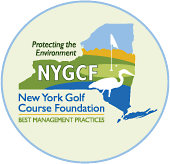Welcome to the New York State Best Management Practices blog page. On this page we will be providing news, information, and insights on the use of Best Management Practices to protect natural resources. To be notified of new postings, please sign up using the form at right. Sign up to receive the latest BMP […]
Privacy Policy This site is owned and operated by Best Management Practices for New York State Golf Courses (BMPNYSGC). Your privacy on the Internet is of the utmost importance to us. BMPNYSGC will not share information about individual users with any third party, except to comply with applicable law or valid legal process or to protect the personal safety of our users or the public. Because you voluntarily share certain types of information with us, we feel you should fully understand our policy and the terms and conditions surrounding the capture and use of that information. This privacy statement discloses […]
May 21, 2019 by NYS BMP · New York State’s golf course BMPs were first published in 2014. Now five years later, we are updating the BMPs, in some cases adding new and updated information, including incorporating the pollinator BMPs (published in 2017). We have also incorporated discrete BMP statements to complement the BMP principles we identified in the first edition. As part of the process of revising and updating, we are seeking input from superintendents across the state and the state’s regulatory agencies to review the draft final version and provide comments to NYGCF. Any superintendent or asst. superintendent in NYS is […]
April 7, 2017 by NYS BMP · While the NYS BMP Committee is hard at work formulating BMPs for pollinator protection on the state’s golf courses, an increasing amount of information is available to help golf course superintendents protect pollinators by minor modifications to management regimes and to enhance habitat to help sustain pollinator populations. Selected publications and websites are briefly described below: Websites: New York State Integrated Pest Management, Cornell University IPM program web page with resources specific to pollinators and related links to additional information. Pollinator Network @ Cornell. Listing of pollinator-related publications and information. New York State Pollinator Protection PlanNYS […]
Overview New York’s golf course superintendents are dedicated to protecting the state’s natural resources. As a demonstration of this commitment, superintendents have partnered with Cornell University scientists and the New York Department of Environmental Conservation to develop and document best management practices (BMPs) for golf course management. BMPs help golf course superintendents protect our state’s surface and groundwater resources, provide habitat for wildlife, reduce pesticide usage, and conserve energy. We have developed these research-based, voluntary guidelines specifically for our state. By documenting and implementing these practices across the state, we hope to showcase our role as environmental stewards and […]
Planning Step Description Assemble Team The team should include, but not be limited to, a golf course architect, golf course superintendent, clubhouse architect, irrigation engineer, environmental engineer, energy analyst, economic consultant, civil engineer, soil scientist, golf course builder, biologirst or ecologist, and a legal team. For new golf courses, a licensed golf course designer is required by law to guide the site analysis process. Define Objectives Identify realistic goals, formulate a timeline, etc. Conduct a Feasibility Study Evaluate finances, environmental issues, water availability and sources, and energy, materials, and labor needs. Identify applicable government regulations. Select and Analyze Site […]
By John Hoyle, CGCS, Corning Country Club When comparing the nutrient, pesticide and water use inputs between various suitable fairway turgrass species and varieties, bentgrass is, in northern climates, head and shoulders above the rest. This concept is impactful from an environmental perspective, but how does it impact other important factors i.e. budget, golfer satisfaction, etc.? Significantly! For example, reductions in irrigation and fertilizer requirements of creeping bentgrass (Jacobs & Gross, 2019; Dobie, 2020) as well as fairway fungicide use (Bekken et al., 2021) suggest that the ROI of installing creeping bentgrass can be as little as 1.3 years (Jacobs […]
January 15, 2020 by NYS BMP · Do you have a stream on your golf course property? Interested in a way to measure water quality without spending a lot on costly testing, learn a thing or two and have some fun at the same time? One method is to examine what is living in it – in particular the benthic macroinvertebrates. These insects live underwater in our streams and rivers, lack a backbone, and can be seen by the naked eye. The NYSDEC program called WAVE (Water Assessments by Volunteer Evaluators) is a project where volunteers collect, or sample “stream bugs” to assess water quality […]
6 Nutrient Management All plants require nutrients to sustain growth and development. Certain essential nutrients are classified as either macro- or micronutrients, based on the amount needed by plants rather than their importance for plant growth. Macronutrients include nitrogen (N), phosphorus (P), potassium (K), calcium (Ca), sulfur (S), and magnesium (Mg). Micronutrients include iron, zinc, copper, chlorine, nickel, molybdenum, boron, and manganese. Micronutrients are required in significantly lower amounts than macronutrients. However, a deficiency or excess of these micronutrients can have a profound influence on plant growth. Proper nutrient management usually includes the following steps: Determine plant needs (such as […]
8 Integrated Pest Management Sooner or later, pests can become a problem, especially when turf is stressed, such as when heat, drought, or high humidity conditions persist. Pesticides alone will not control pests; a more effective approach is to develop an Integrated Pest Management (IPM) program to reduce pest damage and reliance on pesticides. IPM is a sustainable approach to managing pests by combining biological, cultural, physical, and chemical tools in a way that minimizes economic, health, and environmental risks and maintains turfgrass quality. By following the latest research, managers can have high quality playing surfaces with minimal impact on […]
